
Current Status of the Pyongsan Uranium Concentrate Plant (Nam-chon Chemical Complex) and January Industrial Mine
Key Findings
- Commercial satellite imagery collected from April through October 2021 continues to demonstrate that despite the absence of any nuclear testing by North Korea since 2017 the Pyongsan Uranium Concentrate Plant remains operational, continues to be maintained, and is producing uranium concentrate (U3O8, “yellowcake”).
- The Pyongsan Uranium Concentrate Plant remains the sole verified producer of uranium concentrate in North Korea. As such it represents the foundation upon which the nation’s production of fissile material for nuclear weapons is built.
- Given the observed level of activity and North Korean statements concerning the importance of continued development of nuclear weapons and ballistic missiles, and barring any unforeseen developments, the plant will undoubtedly remain operational for the foreseeable future.
- The dismantlement of the Pyongsan Uranium Concentrate Plant should be an essential component to any meaningful future “complete, verifiable, irreversible dismantlement” nuclear agreement between the United States and North Korea.
- Given known North Korean industrial practices, observed waste storage practices, and health and safety concerns raised by defectors and outside observers, there are likely to be numerous health, safety, and environmental issues surrounding the operations (and any decommissioning efforts) at the Pyongsan Uranium Concentrate Plant and its related facilities.
The Pyongsan Uranium Concentrate Plant
The Pyongsan Uranium Concentrate Plant remains the sole verified producer of uranium concentrate (U3O8, “yellowcake”) in North Korea. As such it represents the foundation upon which the nation’s production of fissile material for nuclear weapons is built. Analysis of commercial high-resolution satellite imagery acquired from April through October 2021 continues to demonstrate that the Pyongsan Uranium Concentrate Plant and its associated support areas, tailings pond, and uranium mining complex (January Industrial Mine) remain operational and are continuing to be maintained. Given the observed activity and continuing North Korean statements concerning the importance of continued development of nuclear weapons and ballistic missiles, the plant will undoubtedly remain operational for the foreseeable future barring any unforeseen developments.

This report provides an update to Beyond Parallel’s reports on the Pyongsan Uranium Concentrate Plant published during May and August 2020, and March 2021. Readers are encouraged to read those reports for a more comprehensive appreciation of the development and operations of the facility.
Main Plant
The main plant of the Pyongsan Uranium Concentrate Plant continues to show activity consistent with the continued production of uranium concentrate and ongoing maintenance efforts.

While no activity of significance is noted in the headquarters and administration area, ongoing operations are observed at the leaching and classifying building. Notably, at least seven of the eight open-air settling tanks (two partially hidden in the shadow) on the north side of the building are in use. While the roof is once again showing signs of deterioration (challenging to see in the October 13 image) with some panels having been replaced and others in need of replacement. This deterioration is caused by acid vapor condensing on the underside of the roof panels.

At the sampling and grinding building continuing accumulation of dust from ongoing sampling and grinding operations is observed as well as the replacement of some roof panels. On the northeast corner of the building the three new open-air settling tanks or ore bins remain empty.
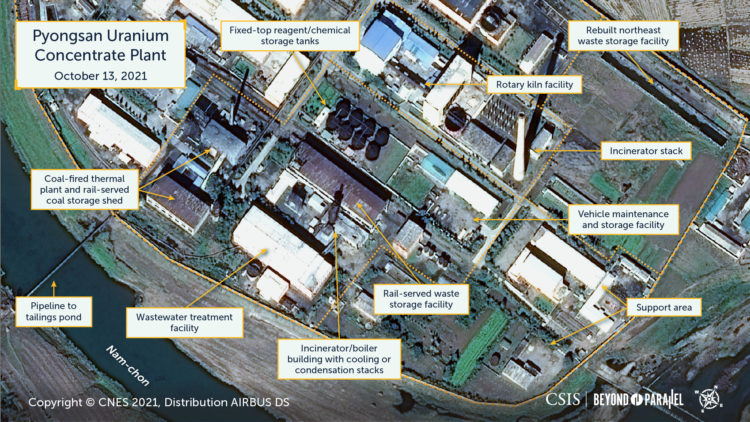
The large waste storage facility immediately to the east of the sampling and grinding building is empty. Immediately outside the eastern security wall is a small compound that continues to show minor activity. The purpose of this compound and its relationship with the plant are unknown.
Support Areas
During the period under study only minor activity such as the movement of trucks and supplies is observed in the west support area. The footbridge across the Namch’on (Namch’on River) between P’yŏnghwa-ri and the west support area that was damaged and then washed away during the 2020 typhoon season has not been rebuilt.
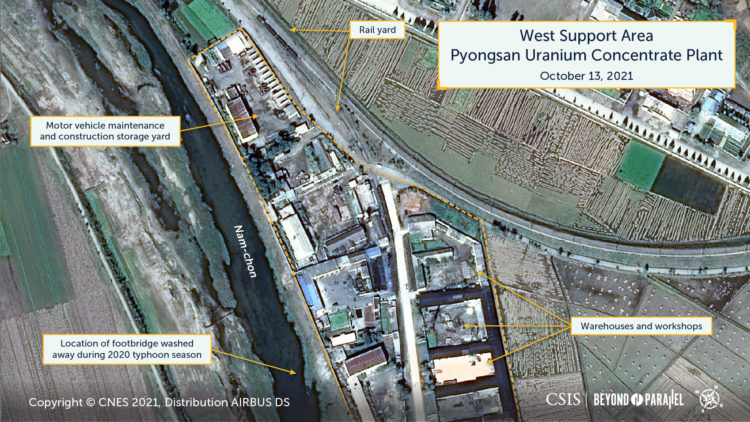
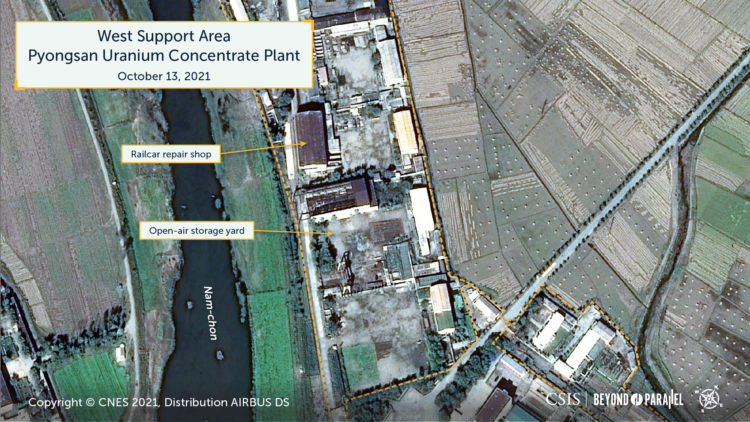
The activity previously observed in the transformer yard in the north support area, suggesting an effort to expand its capacity has not resulted in any significant development.
Railyard
The railyards serving the main plant and west support area have remained active in all imagery of the plant between April through October 2021. The number of locomotives and railcars present have ranged from 28 to 35—higher numbers than have previously been observed. Typically, only one locomotive is present, and the remaining railcars are relatively evenly divided between tank cars (used to transport gaseous or liquid cargos) and gondolas (an open-top rail car used to transport mixed or bulk cargos including various types of ore or waste).
Tailings Pond
The tailings pond located on the south side of the Namch’on remains operational. Both precipitated solid and liquid waste continue to accumulate here. A slurry of solid and liquid waste is pumped from the wastewater treatment building in the main plant to the tailings pond via an approximately 380-meter-long pipeline. At the northeast corner of the dam, a pumphouse then distributes the slurry into the tailings pond via ditches or moveable pipes laid on the surface of the sediment or to a second pumphouse to the south. This second pumphouse then distributes the slurry further south into the eastern bays of the tailings pond. Satellite imagery from April through October 2021 shows that the two pumphouses remain operational and that there have been some minor rearrangements to the movable pipes. The visible precipitated solid waste continues to block five bays of the pond.
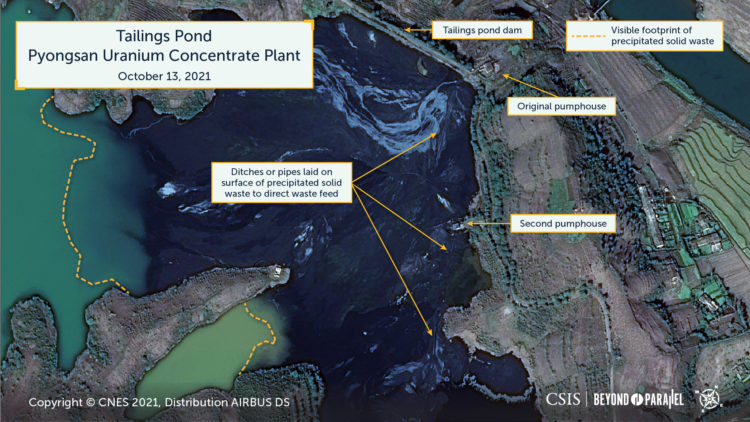
Agricultural Dam
At the small agricultural dam immediately east of the main plant water from recent rains continues to overflow the top of the dam, however, no damage is observed. The road bridge 170 meters downriver of the dam appears to be in a good state of repair and being used.

Uranium Mining Complex (January Industrial Mine)
Beginning approximately 600 meters to the northeast of the main plant and covering approximately 235 hectares is the Pyongsan Mining Complex (January Industrial Mine). Satellite imagery from April through October 2021 indicates that the complex remains operational. One, potentially two, of the original five mining shafts are operational, the tailings piles west and northwest of the ore processing facility continue to show minor activity. Typical seasonal activity is noted in the adjacent village of Panma.
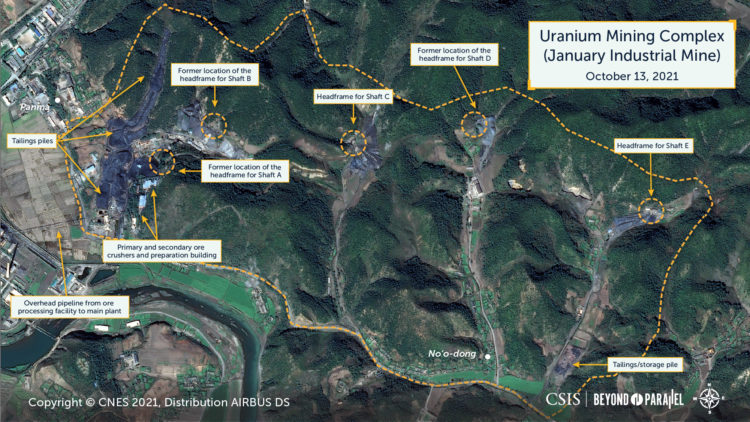
While the length of the tailings pile up the valley to the north-northwest of the ore processing facility has remained relatively unchanged at approximately 420 meters in length, continue activity is noted along its lower half and its access roads appear to be well trafficked.

Shaft A: The headframe (i.e., the frame structure above the mine shaft used to raise and lower workers, equipment, and ore) was removed during early-2015 and the shaft abandoned.
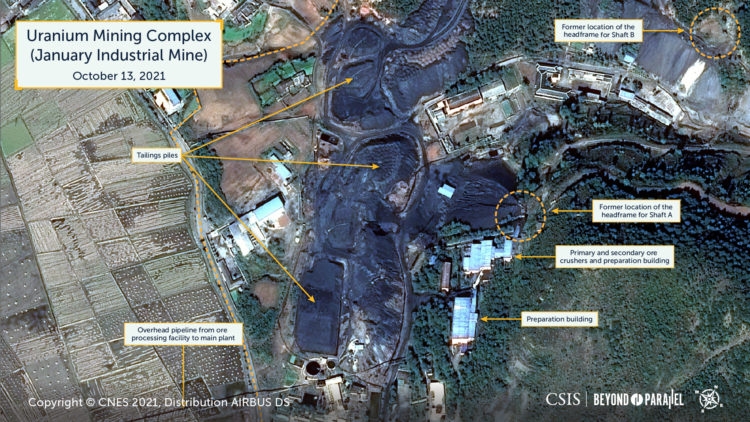
Shaft B: Sometime between July 18, 2019 and September 13, 2019 the headframe for Shaft B was removed and the shaft is no longer operational. Except for erosion, no activity is observed on the adjacent tailings pile.
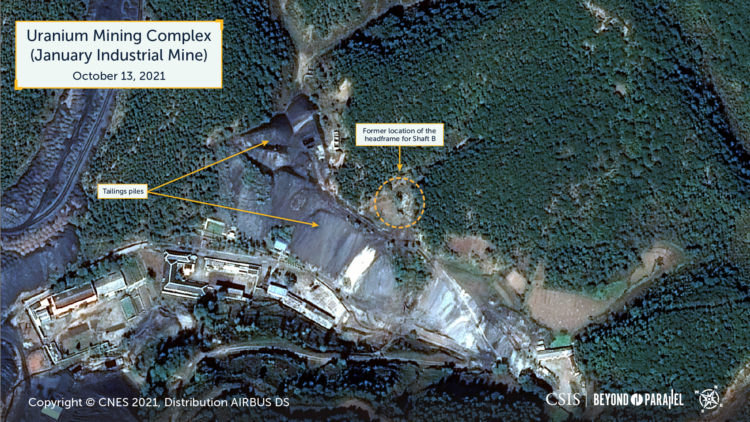
Shaft C: While the headframe for the shaft appears to still be present no activity of significance is noted on the adjacent tailings pile. Operations at Shaft C may be suspended or at a very low level.
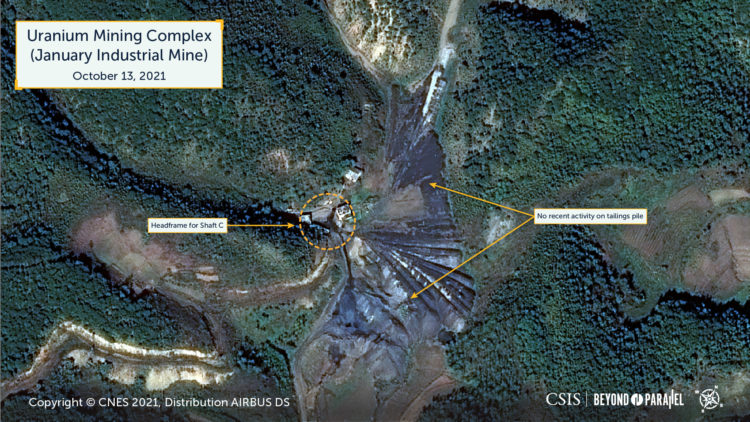
Shaft D: The headframe for this shaft was removed between early- to mid-September 2015 and it is no longer operational. Except for erosion, no activity is observed on the adjacent tailings pile.
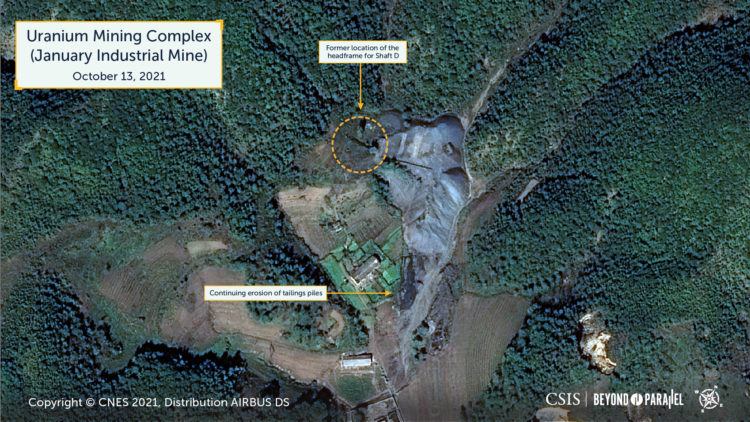
Shaft E: This shaft appears to be operational as the new headframe first observed during July 2018—the original having been removed between 2013 and 2017—remains in place. Sometime between June 2020 and March 2021 one building was refurbished and a second new building was constructed adjacent to the headframe. During July-August 2021, a covered conveyor belt was added leading from the headframe to the east side of the tailings pile. Changes to the tailings pile continue to be observed.

As noted in previous reports no significant changes are noted to the very minor tailings (likely related to some minor exploratory or artisanal mining) approximately 175 meters northeast of Shaft E.
Tailings/Storage Pile: Approximately 625 meters to the south of Shaft E is an old tailings/storage pile. Only minor changes are observed to the pile since May 2021, and these appear to be due solely to erosion or small excavation efforts.

Research Note
This report is part of a comprehensive long-term project undertaken by the Center for Strategic and International Studies’ (CSIS) Korea Chair to use satellite imagery, interview data, declassified documents and open source information to identify and document the organization, development, operations and status of North Korea’s nuclear program. It is based in part upon a study of North Korea’s nuclear program and infrastructure begun by Joseph S. Bermudez Jr. in 1988 and now continued by the Korea Chair. Various parts of the original study were subsequently published by the author over the years. The information presented here supersedes or updates these and other previous works by the author and Korea Chair on these subjects.
